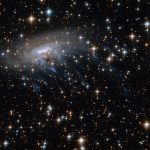Jellyfish Galaxies and Their Magnetic Fields
While we know that the magnetic fields in galaxies can contribute to star formation, one type of galaxy has left scientists questioning this fact. So called “jellyfish galaxies' ' fall into the center of a galaxy cluster, which get their name from their jellyfish-like tails. It’s been theorized that the rarified gas of jellyfish tails can also form stars, but research hasn’t been able to confirm this as these galaxies are difficult to study due to their low brightness. That is until now.
A Look Into the Study
The tail of jellyfish galaxies is formed by interstellar gas moving in opposite directions. When observing one jellyfish galaxy in particular, JO206, an international team of astronomers have found that they can study its magnetic field to get the answers they’ve been looking for. The German-Italian team that conducted the study had their results published in the peer-reviewed journal Nature Astronomy. By using this work-around and studying the magnetic field structure, they’ve shown that not only is the magnetic field strong, but the gas tail also has a field that is aligned very precisely along the galaxy’s “tentacles,” or tail, where active star formation is taking place.” This observation is the first and so far the only investigation of it’s kind in a jellyfish galaxy.
How They Did It
Computer simulations were able to construct scenarios to study. "While the jellyfish galaxy flies through the galaxy cluster, its magnetic field wraps around the galaxy like a mantle and is further amplified and smoothed by the high galaxy speed and cooling effects," explains co-author Christoph Pfrommer. This process could amplify the magnetic field of JO206 and also generate the high proportion of polarized radiation.
From the simulations, they were able to develop the following theory: JO206 falls at high speed into the center of the galaxy cluster, so that the magnetic fields interact and hot winds from the medium between the galaxies lead to accumulations of plasma. A percentage of the plasma condenses on the outer layers of the gas tail, where it mixes with the remaining matter.
With this research, they can now move on to studying other galaxies with similar tails using radio telescopes in Australia, South Africa, and the U.S. Further research into if this phenomenon is expected, as more observations can allow us to understand what connection exists between the magnetic field and the star formation outside galaxy disks.
Keep Up To Date With Apex Magnets
For the latest magnetic discoveries and news, make sure to subscribe to our monthly newsletter or browse our blog and follow along with topics like magnet facts and magnet experiments!
Photo credit: NASA

